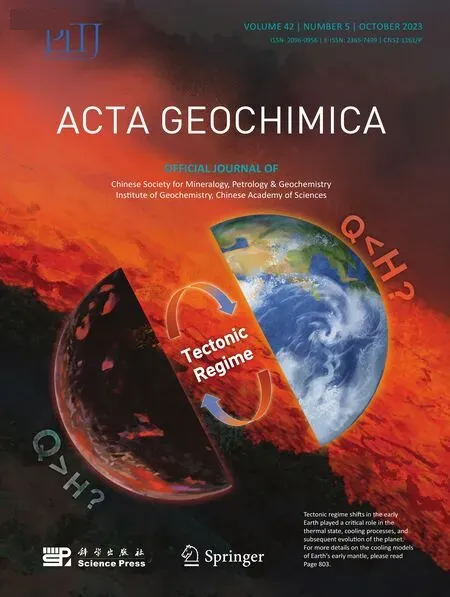Petrology of lherzolite xenoliths of Hosséré Sédé volcano(Adamawa plateau,Ngaoundéré area,Cameroon)
O.F.Nkouandou · J.M.Bardintzeff · Fagny Mefire · Njankouo Ndassa ·A.A.Sahabo · H.Adama
Abstract Numerous mantle xenoliths 6–12 cm in size and sub-angular to rounded in shape occur within Mio-Pliocene basanite lavas of the monogenic volcano of Hosséré Sédéin the Adamawa plateau.Xenoliths of spinel lherzolite exhibit protogranular,equigranular or porphyroclastic texture.Microprobe chemical analyses show that olivine is highly magnesian (Fo88-90),clinopyroxene crystals are diopside and augite (Wo41.6–49.6 En45.3–53.7 Fs4.2–6.2),orthopyroxene crystals are enstatite (Wo1.4–1.5 En88.6–89.0 Fs9.6–9.9) and spinel crystals are mainly Al-spinel associated to minor Cr-spinel.Estimated temperatures and pressures through empirical formulas show that HosséréSédé xenoliths have equilibrated between 1085 and 1204°C and 1.08 to 1.57 GPa,corresponding to sampling depths of 36 and 52 km.Detailed petrographical and mineral chemistry of Hosséré Sédé xenoliths evidences the complex nature and composition of the subcontinental lithosphere under the Adamawa plateau.This may involve a probable uplift of the whole area after a limited extensional event,possible metasomatism through melt infiltration during shearing of the lithospheric mantle along the Pan African strike-slip fault system.
Keywords Cameroon · Adamawa · Hosséré Sédé ·Subcontinental lithosphere · Xenolith · Peridotite ·Lherzolite
1 Introduction
Cameroon Volcanic Line,Benue Through and Adamawa plateau are major tectono-volcanic structures in central Africa(Fig.1A and B).The alignment of volcanoes on the Cameroon Volcanic Line has been interpreted as the result of the locally weakened continental crust due to inherited discontinuities from the Pan African orogeny and reactivated during Mesozoic and Cenozoic times (Moreau et al.1987;Fagny et al.2016,2020).
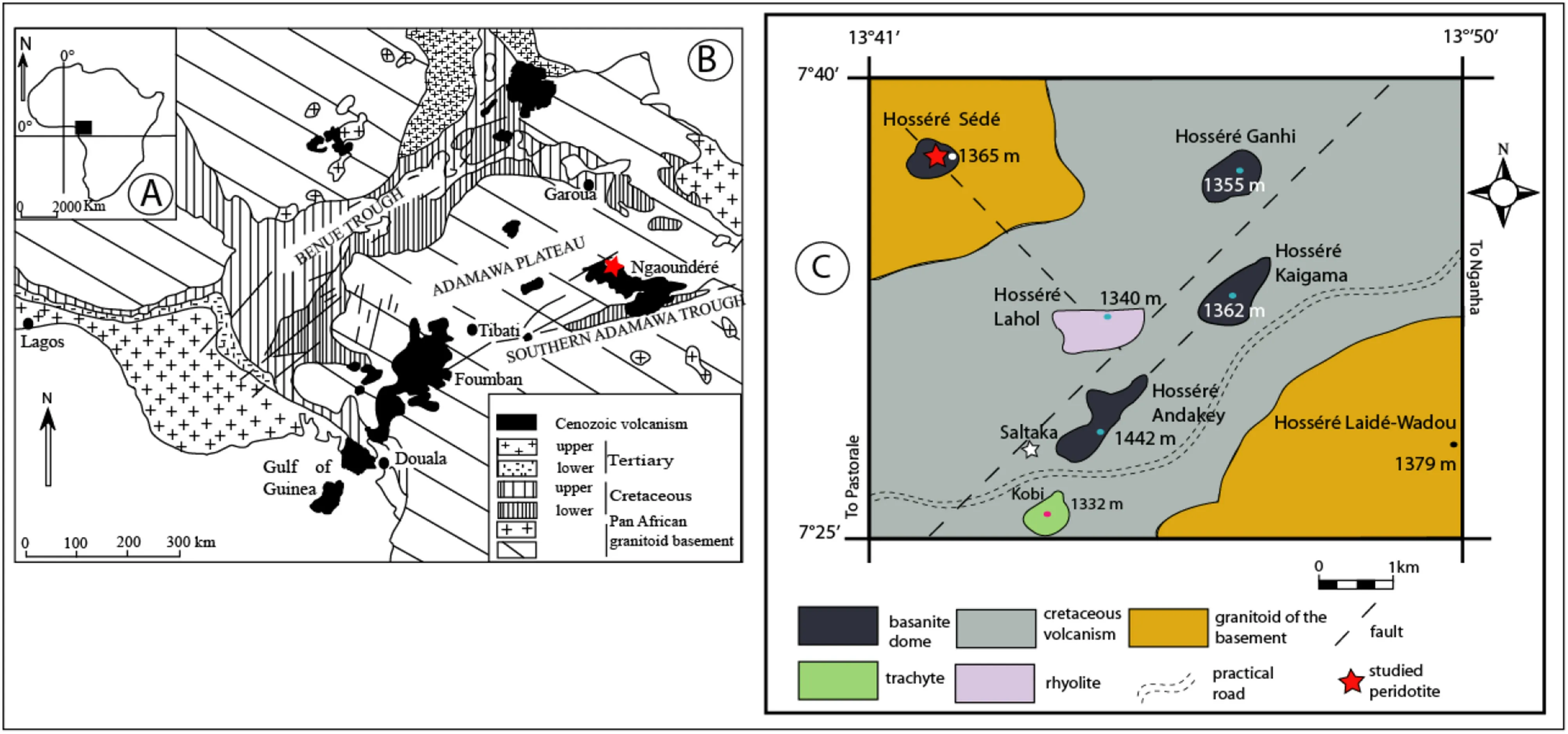
Fig.1 A Location in Africa,B Main tectono-magmatic structures in Cameroon,modified after Dumont (1987),in black is the Cenozoic volcanism of the Cameroon Volcanic Line,red star=studied area,C Geological sketch map of Saltaka–Hosséré Sédé area
The nature and composition of sub-continental lithospheric mantle under those structures are rather well documented.The mechanical behavior and the relationships between tectonic features and rigidity of the subcontinental lithosphere under the Cameroon Volcanic Line and Adamawa plateau were investigated,using gravity data (Poudjom Djomani et al.1992,1995),and magnetic data for Benue Trough(Ofoegbu 1984;Shemang et al.2001).
The continental crust of the Adamawa plateau is about 30 km thick (Poudjom Djomani et al.1995;Nnange et al.2000;Goussi Ngalamo et al.2017),and likely thinner in its northern part where the ascent of magma was facilitated by Pan African strike-slip faults straddling crust and subcontinental mantle down to asthenosphere (Dorbath et al.1986).Cenozoic uplift of the Adamawa plateau might have been associated with the upwelling of the underlying mantle,which underwent decompression-induced melting(Nkouandou et al.2008,2010,2015;Njankouo Ndassa et al.2019).Sub-continental peridotite fragments sampled by ascending basaltic magmas on their way to the surface have certainly recorded mechanical markers and composition of the lithospheric mantle under the Adamawa plateau.
Peridotite xenoliths that we recently discovered in Hosséré Sédé volcano,north of Ngaoundéré in the Adamawa plateau (Fig.1C) could offer more information on the structure and composition of the underlying lithospheric mantle.
This work aims to obtain precise data on the chemistry of the mineral phases constituting the xenoliths and to calculate the temperature and pressure conditions of their formations at depth for a better knowledge of the lithosphere in this area.
2 Geological setting
Adamawa plateau in central Cameroon is a volcanic and tectonic dome structure within the Pan-African belt of Cameroon(Fig.1B).It is covered by 11–7 Ma basaltic and felsic volcanic formations (Temdjim et al.2004;Nkouandou et al.2008).Its basement is composed mostly of 630–620 Ma pre-to syn-D1,580–600 Ma syn-D2,and 550 Ma post-orogenic granitoid (Toteu et al.1987,2001;Toteu 1990).Neoarchean to Paleoproterozoic pyroxene-and amphibole-bearing gneisses located south of Meiganga display geochemical characteristics of Archean TTG(tonalite—trondhjemite—granodiorite) and yield207Pb/206Pb single-zircon evaporation ages of 2.6–1.7 Ga(Ganwa et al.2008).Adamawa plateau is bounded north and south by Pan African strick-slip faults,the reactivation of which has favored Cenozoic uplift (Ngangom 1983;Dumont 1987;Moreau et al.1987).Geophysical studies on the Adamawa plateau (Poudjom Djomani et al.1992,1995,1997;Nnange et al.2000,2001)identify broad negative and central positive Bouguer anomalies deduced from the Bouguer anomaly map of Cameroun corresponding to lithospheric and crustal thinning,respectively.Four major density discontinuities have been determined within the lithosphere beneath the Adamawa uplift using spectral analysis of gravity data (Nnange et al.2000): (1)the first discontinuity is located between 7±0.5 and 13±1 km;(2)between 19±1 and 25±4 km;(3)between 30±2 and 37±2 km and (4) 75±10 and 149±27 km.The deepest discontinuity depths suggest the presence of an anomalous low-velocity upper mantle structure,already deduced from teleseismic delay time studies (Poudjom Djomani et al.1992).The 30–37 km depths correspond to Moho’s average depth of 33 km below the Benue trough and Adamawa dome and the intermediate depths of 10 and 20 km obtained may correspond to intracrustal discontinuities.
3 Materials and methods
Sampled peridotites recently discovered in Hosséré Sédévolcano were studied for petrography using 5 thin sections prepared at the laboratory GEOPS (GEO sciences Paris-Saclay),University Paris-Saclay,France.Modal proportions of the four major mineral phases (olivine,clinopyroxene,orthopyroxene,and spinel) of studied lherzolite peridotites selected for this work have been estimated from percentage areas of each crystal under the polarizing microscope and Scanning Electron Microscope(SEM) in the laboratory GEOPS,University Paris-Saclay,France.Microprobe mineral analyses of ultramafic xenoliths were performed on Camebax SX100 at the service Camparis of the University Paris-Sorbonne,France.The operating conditions were accelerating voltage and beam current as follows:olivine and pyroxene:15 kV and 40 nA,20 s except Si for olivine(10 s)and Ti for pyroxene(30 s);titanomagnetite: 15 kV and 40 nA,Si,Ca,Ni: 10 s;Mn:25 s;Cr:15 s;Al:30 s;Ti,Fe,Mg:40 s.The standard used was a combination of natural and synthetic minerals.Data corrections were made using the PAP correction of Pouchou and Pichoir (1991).
4 Results
4.1 Field-work and petrography
Studied peridotites have been sampled at the right hillside and top of Hosséré Sédé volcano located 7°39’ N and 13°41’ E (Fig.1C,Table 1),4 km NNW of Saltaka and 35–40 km N of Ngaoundéré.The volcano,culminating at altitude of 1365 m(Fig.2A)and towering 144 m above the basement,was emplaced at the crossing of the 70°N and 135°N Pan African fault network of the northern Ngaoundéré area as fissural volcanism.Hosséré Sédé volcano forms a dome shape form without a crater,280 m in diameter,with gentle slopes.The volume of basaltic lavas is 11 500 000 m3.Hosséré Sédé volcano does not display lava flows but 25–70 cm basaltic blocks and rare up to 1.7 m boulders,with 5–10 cm cavities (Fig.2B).Some of them contain fragments of mantle peridotite(Fig.2C).The top of Hosséré volcano is essentially covered by small (<40 cm in size) blocks,whereas,at the base,larger (0.7–1.7 m)blocks hide the contact with the granitoid basement.

Table 1 GPS coordinates of Hosséré Sédé xenolith samples

Fig.2 A Panoramic view of Hosséré Sédé volcano,B Vesicular structure of basaltic block lava,C Angular peridotite xenolith enclosed in basalt
Basaltic blocks,coated by thin 2–5 mm brown patina,are composed of a dark matrix containing phenocrysts of olivine (3–6 mm,10–15 vol%),pyroxene (2–5 mm,5–8 vol%) and sparkling microliths of plagioclase (25–30 vol%).Under the microscope (Fig.3A),basalt shows porphyritic microlitic texture.Olivine xenocrysts are free of oxide inclusions,contrary to olivine phenocrysts including oxide microcrysts.Minute plagioclase microliths are frequently associated with oxide microcrysts.

Fig.3 Photomicrographs of thin sections showing textural variations of basaltic host lava (A) and studied xenoliths (B to F).A Microlitic porphyritic texture of basaltic host lava,B Protogranular texture showing triple point junction between olivine crystals,C Interstitial spinel crystals showing reaction zones,D Iddingsitisation of olivine crystals evidencing fluid infiltration,E Sharp contact between pyroxene and olivine and host lava,F Contact between host lava and skeletal aspect of studied xenolith.oxoxide,splspinel
We observe numerous xenoliths transported to the surface by the basalt.These are more or less altered peridotite enclaves or crumbly granitoid xenoliths.Contacts between xenoliths and basaltic host lava are sharp.
Angular peridotite xenoliths are 6–12 cm long(Fig.2C).They are mainly composed of four minerals—olivine,clinopyroxene,orthopyroxene,and spinel (Fig.3).Large yellow-greenish olivine crystals (67–84 vol%,Table 2)strongly predominate,clinopyroxene crystals are 7–20 vol%,orthopyroxene represent 6–12%and spinel are 1–5 vol%.No hydrous phases,such as amphibole or phlogopite,were observed.The studied xenoliths are classified as spinel lherzolite (Fig.4) as proposed by Le Maitre (2002).
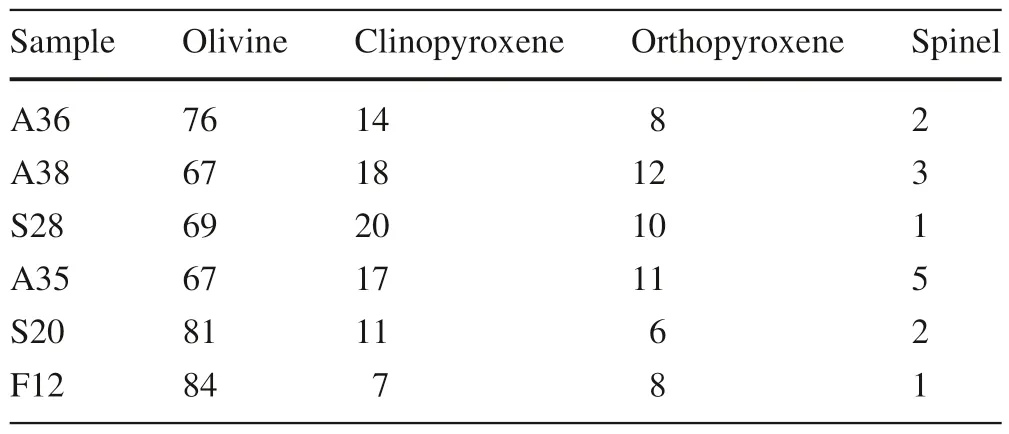
Table 2 Modal compositions of Hosséré Sédé xenoliths
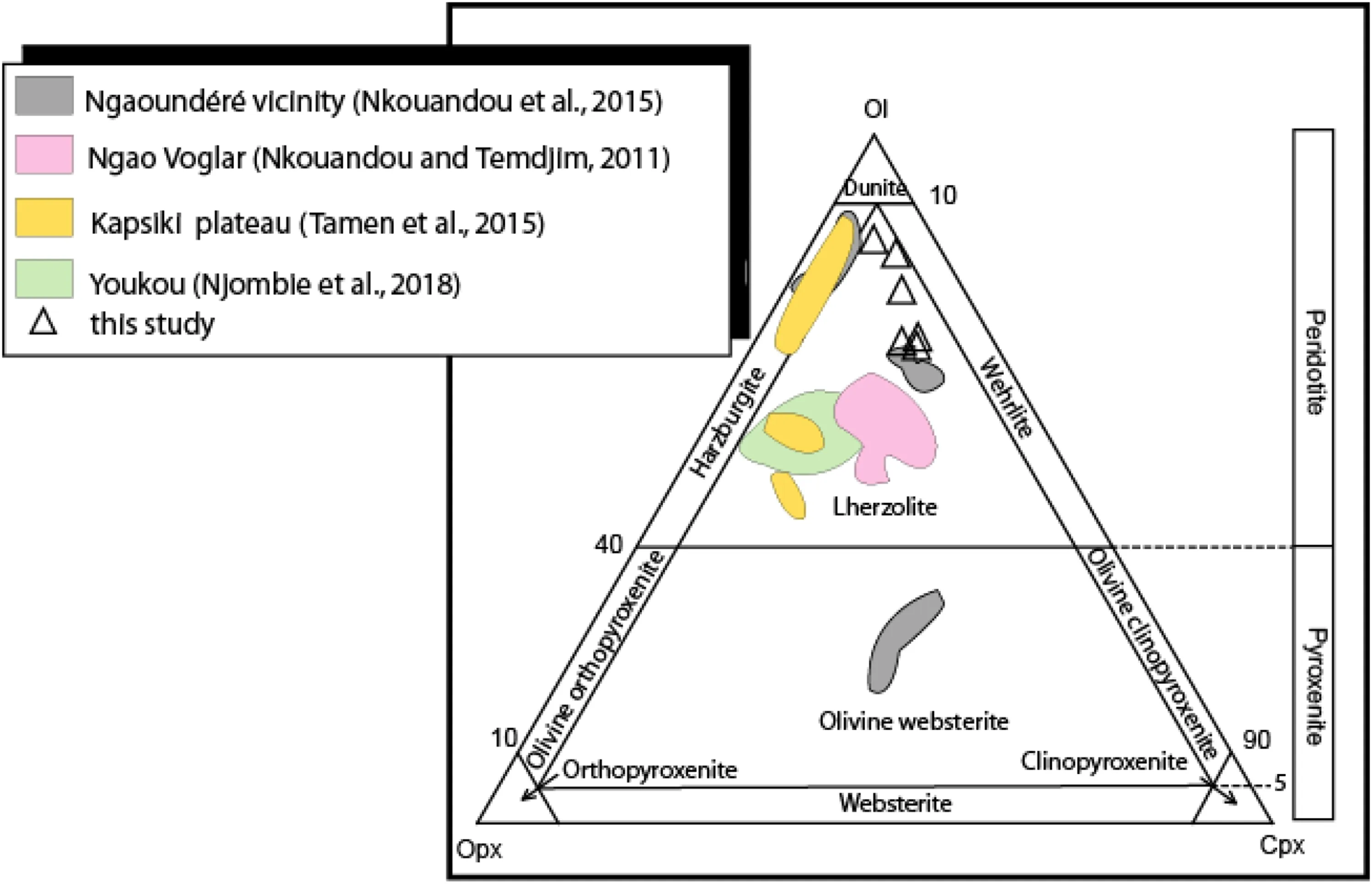
Fig.4 Modal compositions of peridotite xenoliths from Hosséré Sédé volcano
On plate polarised light,all xenoliths exhibit typical protogranular texture,except sample A12 which exhibits equigranular texture after the classification scheme of Mercier and Nicolas (1975).Olivine grains have sizes ranging from 2 to 5 mm,orthopyroxene,and clinopyroxene are 1.5–3.5 mm in size,while spinel is generally 1–2 mm.Spinel occurs as discrete,dispersed,or interstitial grains frequently between olivine and orthopyroxene (Fig.3C).Thin reaction zones always develop around spinel crystals that resemble spongy rims (Fig.3C).In most samples of equigranular texture,olivine phases show iddingsitized boundaries expressed as thin (20–50 µm) yellowish bands(Fig.3D).Contacts between xenoliths and host basaltic lava are sharp (Fig.3E),but sometimes develop skeletal structure (Fig.3F).
4.2 Mineralogy
4.2.1 Host lava
Chemical analyses of the main mineral phases of the host basaltic lava are listed in Table 3.

Olivine phenocryst cores have higher Fo (=100 Mg/Mg+Fe) (Fo81) than rims (Fo76-77) and microcrysts (Fo70-74).CaO contents vary from 0.11 wt% in phenocryst cores to 0.46 wt% in microcrysts while NiO contents (0.13–0.21 wt%) remain relatively low.
Clinopyroxene phenocrysts are mainly diopside in composition (Wo49.5–51En36-39Fs512-13) after the classification scheme of Morimoto et al.(1988)with minor microliths of less calcic composition (Wo48En39Fs12).TiO2(2.80–4.48 wt%) and Al2O3(5.26–8.62 wt%) contents of clinopyroxene are relatively high.Na2O contents(0.59–0.69 wt%) are relatively constant.Note that the clinopyroxene phenocrysts with Wo>50 wt% witness fassaitic compositions like in alkali basalts described by Wandji et al.(2000) in Noun Plain,Cameroon.
Plagioclase crystals (An38-26Ab56-62Or6-14) are mostly andesine to oligoclase.
Moreover,some mineral phases,Na2O(10.3–15.9 wt%)and K2O(1.6–6.8 wt%)rich,present affinities with analcite that give a basanitic character to the host lava.
Ti-oxide is titanomagnetite—titanohematite (TiO2:22.71 wt%;Fe2O3: 18.06 wt% and FeO: 46.79 wt%) with 66.57% ulvöspinel.
4.2.2 Peridotite xenoliths
Chemical compositions of olivine,clinopyroxene,orthopyroxene,and spinel are listed in Tables 4,5,6,7.

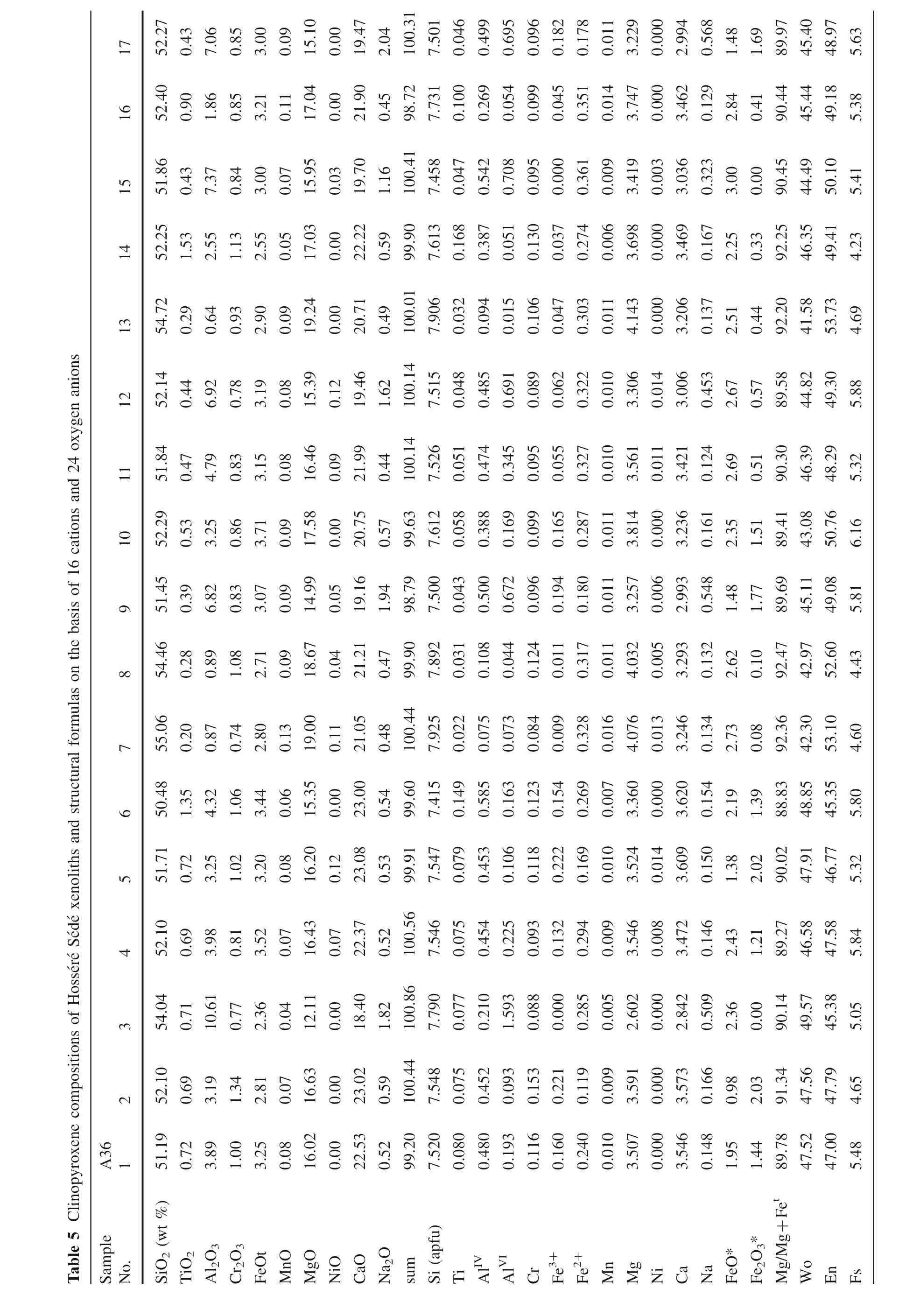
Olivine crystals are highly magnesian (Fo88-90)(Table 4).Low CaO contents (<0.1 wt%) are typical of mantle olivine,except in olivine rims in contact with basaltic host lavas (0.11–0.27 wt%) (Fig.5).NiO contents are high (up to 0.42 wt%) compared to olivine crystals of host basaltic lava (Table 3,Fig.6).

Fig.5 CaO vs Fo diagram for olivine from Hosséré Sédé.Field I for olivine mantle peridotites and field II for magmatic olivine after Simkin and Smith (1970).Cross=host lava,open triangle=lherzolite

Fig.6 NiO vs Mg# (Fo) diagram for olivine from Hosséré Sédé.In brown,field of “West Eifel and Siebengebirge ultramafic xenoliths”after Rizzo et al (2021)
Clinopyroxene is diopside and augite (Wo42-50En45-54Fs4-6) (Table 5,Fig.7) after Morimoto et al.(1988).Mg#ratios (=100 Mg/ Mg+Fe) are high (88.8–92.5) for both diopside and augite,typical of mantle clinopyroxene(Fig.8).TiO2contents are low (0.20–1.53 wt%).Al2O3contents vary widely (0.64–10.61 wt%) whereas Cr2O3contents (0.74–1.34 wt%) are rather high,defining typical Al-Cr clinopyroxenes after Morimoto et al.(1988).Two groups of clinopyroxenes are evidenced: (i) one group (4 analyses) is Al2O3(6.8–10.6 wt%) and Na2O (1.2–1.9 wt%) rich,which include jadeite molecule and (ii) another group (12 analyses),Al2O3(0.6–4.8 wt%) and Na2O (0.4–0.6 wt%) poorer.
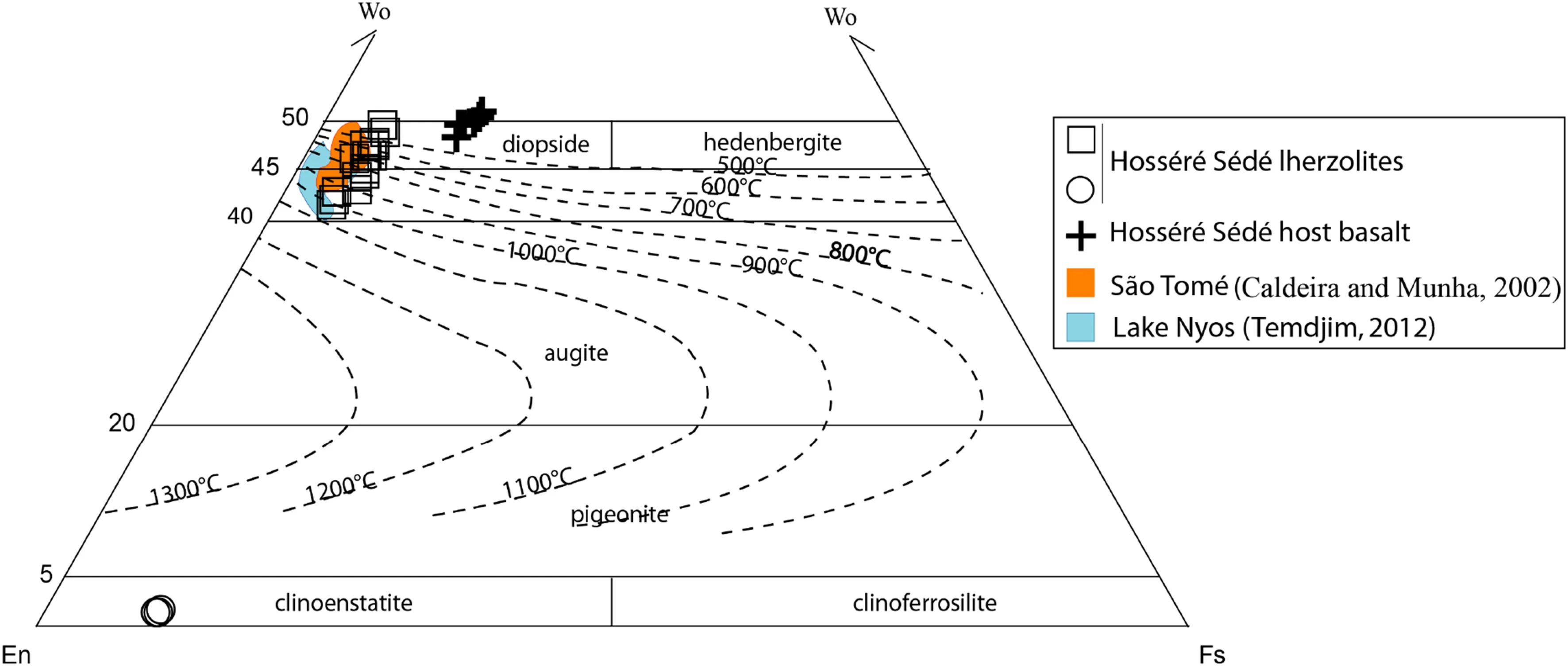
Fig.7 Pyroxene chemical compositions of host lava and lherzolite xenoliths from HosséréSédévolcano in quadrilateral diagram after Morimoto et al.(1988).Clinopyroxenes of peridotites of Lake Nyos,Cameroon,and São Tomé Island are plotted for comparison.Thermometric curves between 500 and 1300 °C according to Lindsley (1983) for P=5 kbar (0.5 GPa).Open square=clinopyroxene,open circle=orthopyroxene
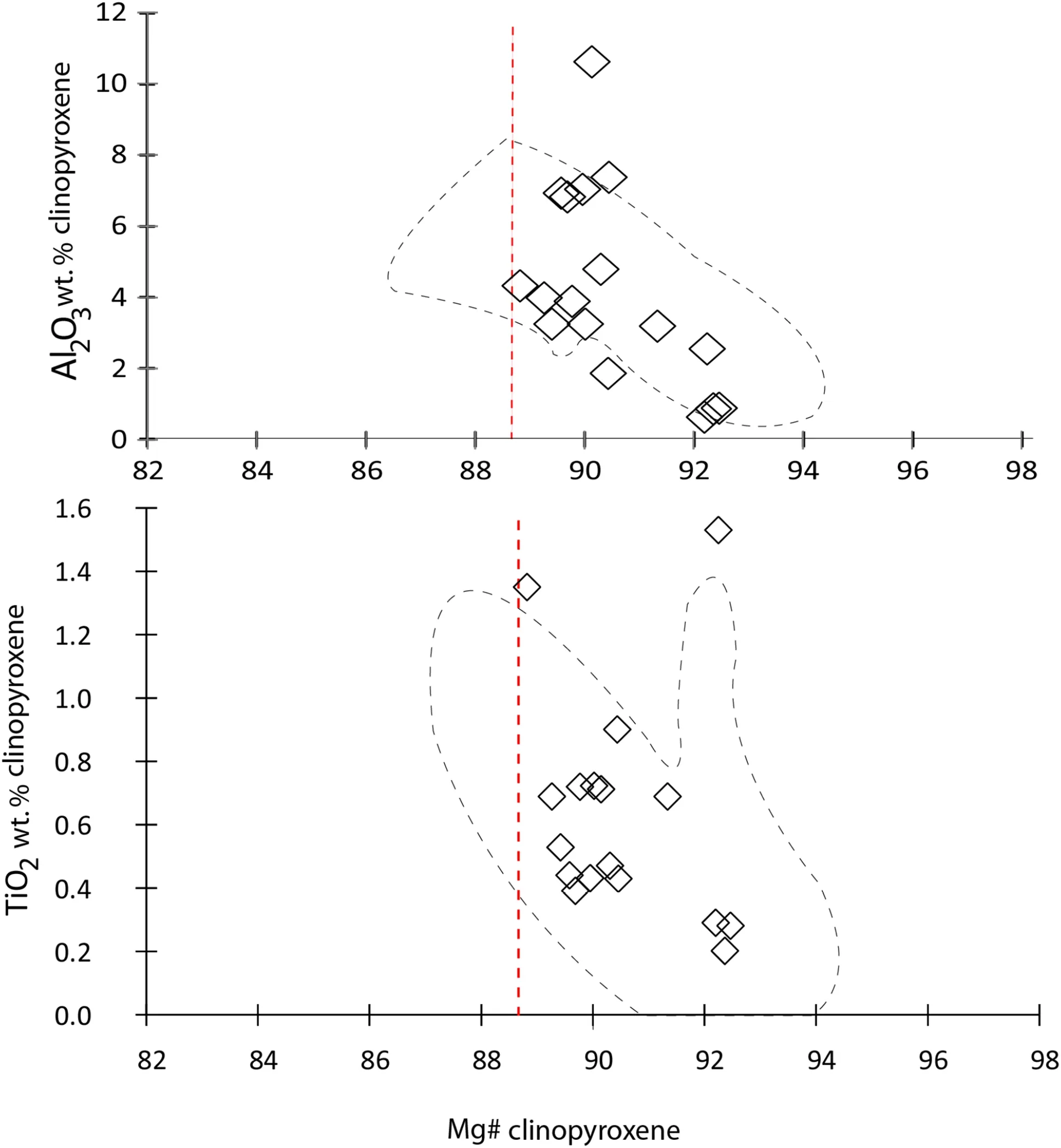
Fig.8 A Al2O3 vs.Mg# and B TiO2 vs.Mg# of clinopyroxene of peridotite xenoliths.Dashed line=field of “West Eifel and Siebengebirge ultramafic xenoliths” after Rizzo et al (2021).Dashed vertical lines represent the Mg# thresholds used to discriminate between cumulates and mantle clinopyroxene
Orthopyroxene is enstatite (Wo1.5En89Fs9.5) type(Table 6,Fig.7) after Morimoto et al.(1988).Mg# ratios are high (90.1–90.5),typical of mantle orthopyroxene(Fig.9).TiO2contents (0.10–0.13 wt%) are very low.Al2O3contents are constant (4.55–4.61 wt%).Na2O contents are also low (0.10–0.15 wt%).
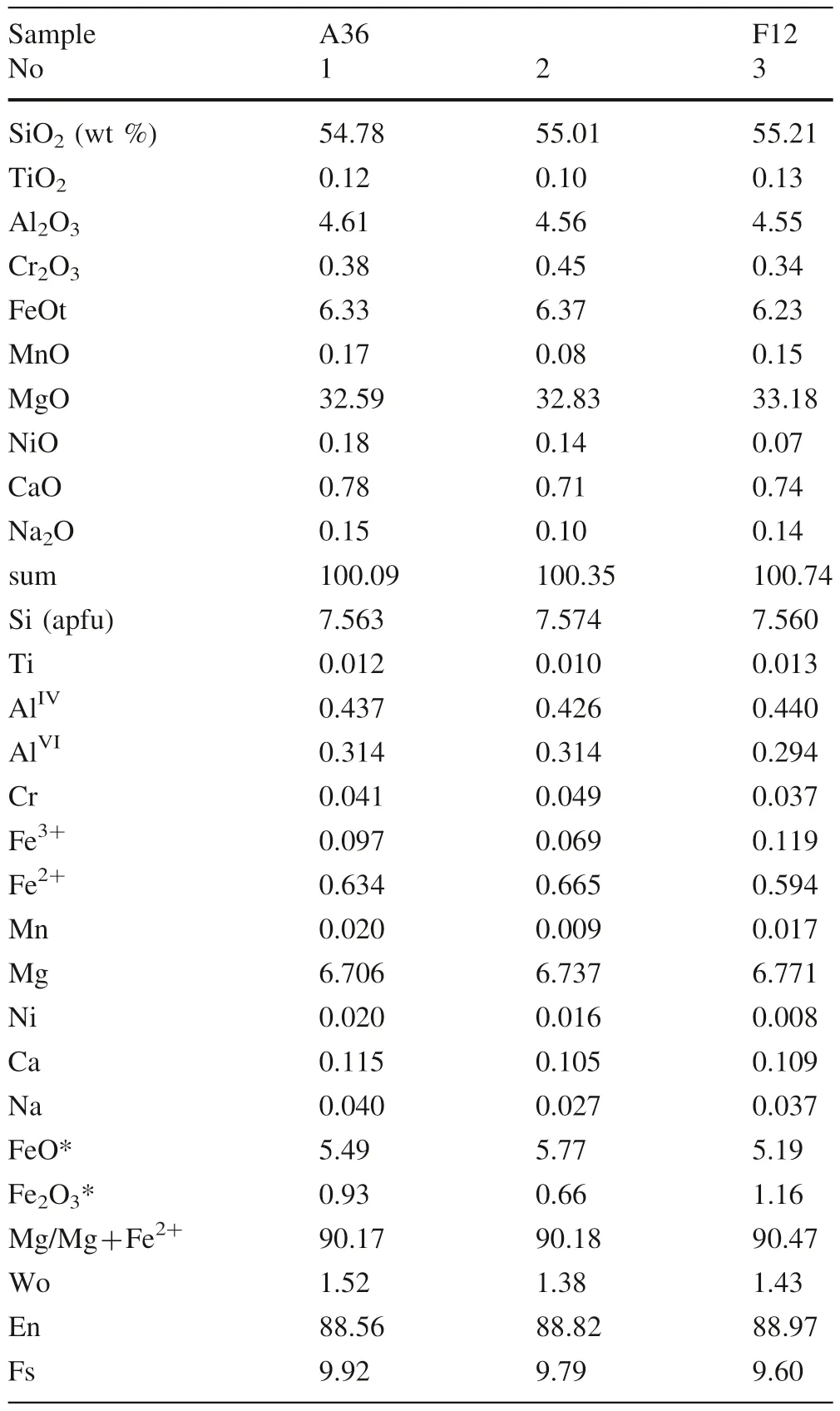
Table 6 Orthopyroxene compositions of Hosséré Sédé xenoliths and structural formulas on the basis of 16 cations and 24 oxygen anions
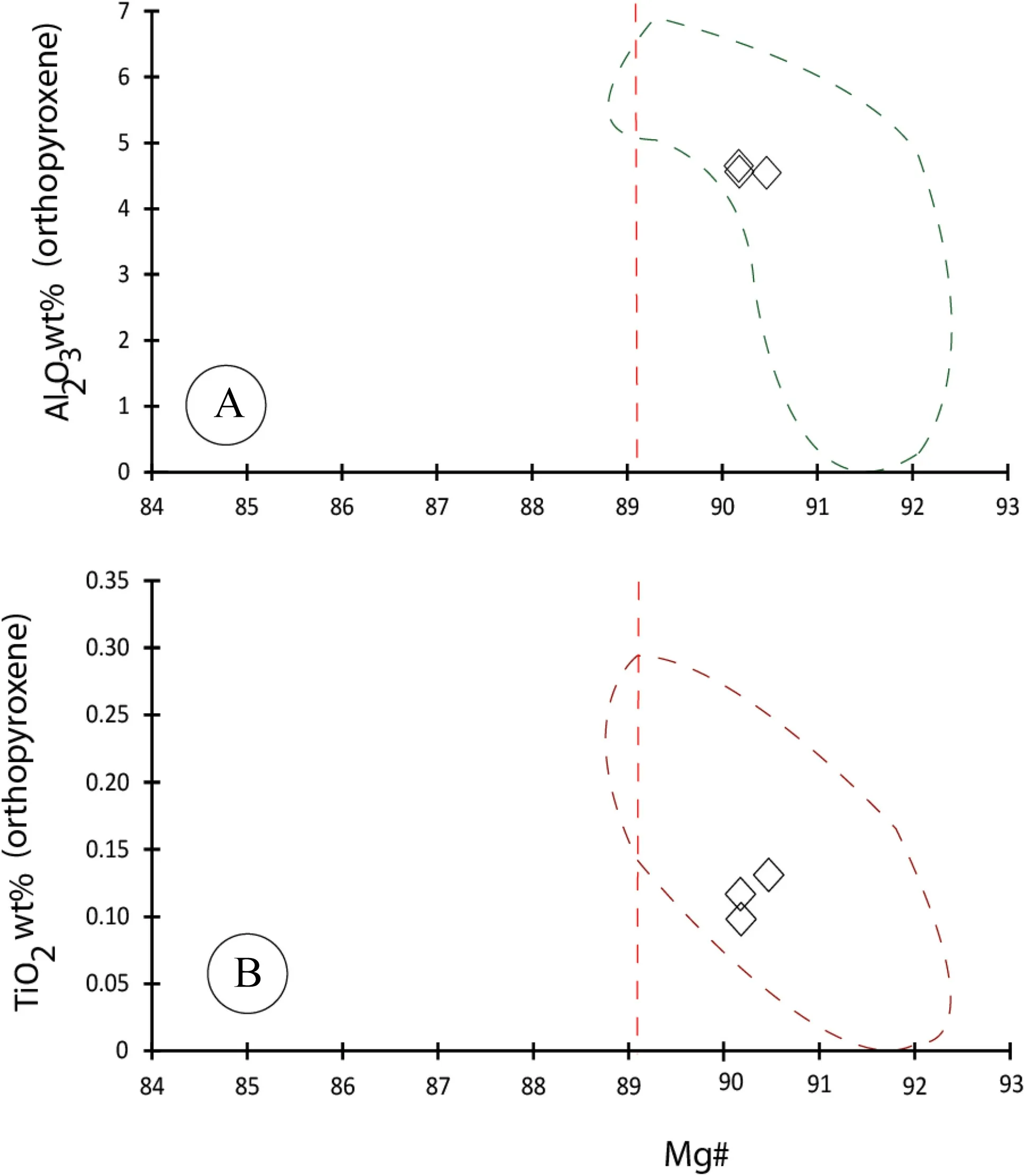
Fig.9 A Al2O3 vs.Mg# and B TiO2 vs.Mg# of orthopyroxene of peridotite xenoliths.Dashed line=field of “West Eifel and Siebengebirge ultramafic xenoliths” after Rizzo et al (2021).Dashed vertical lines represent the Mg# thresholds used to discriminate between cumulates and mantle orthopyroxene
Spinel is dominantly Al-spinel (Al2O3up to 56 wt%)after Carswell (1980) (Table 7).Few crystals are Cr-spinels,with high Cr2O3contents (49.15 wt%).FeO contents in Al-type are lower (11.33–13.79 wt%) than in Cr-type(21.62 wt%).MgO contents are higher (19.52–20.79 wt%)in Al-spinel than in Cr-spinel (10.05 wt%).Al-spinel has higher NiO contents (0.30–0.45 wt%) than Cr-spinel (0.08 wt%).Cr# of Cr-spinel is 73.76 and lower in Al-spinel(11.68–17.63).Mg#is higher in Al-spinel crystals(77.08–80.34)than in Cr-spinel(48.06).Fe3+#[=100*Fe3+/(Fe3++Al3++Cr3+)]ratios of Al-spinel range between 2.16 and 4.31 while those of Cr-spinel(3.44)overlap Al-spinel values.Cr-spinel shares affinities with some Cr-spinels(Cr2O3=46.2–49.5 wt%,Al2O3=16.2–19.5 wt%,MgO=13.1–13.5 wt%,FeOt(total)=19.22–19.57 wt%,NiO=0.14–0.16 wt%) that exist in xenoliths from Scotland(Upton et al.2011).Reversely,Cr-spinel described in Mt.Vulture,Italy(Cr2O3=40.2 wt%,Al2O3=25.0 wt%,MgO=15.7 wt%,FeOt=22.1 wt%,NiO=0.2 wt%;Jones et al.2000) is Cr-poorer but Al-richer.By comparison,Cr-spinel of Andaman ophiolite (Ghosh et al.2012,21,013) is far Cr-richer (Cr2O3=55 wt%,Al2O3=15 wt%,MgO=14 wt%,FeOt=17 wt%,NiO=0.1 wt%).Rizzo et al.(2021)described spinels with Cr# between 9.5 and 57.2 in West Eifel ultramafic xenoliths.
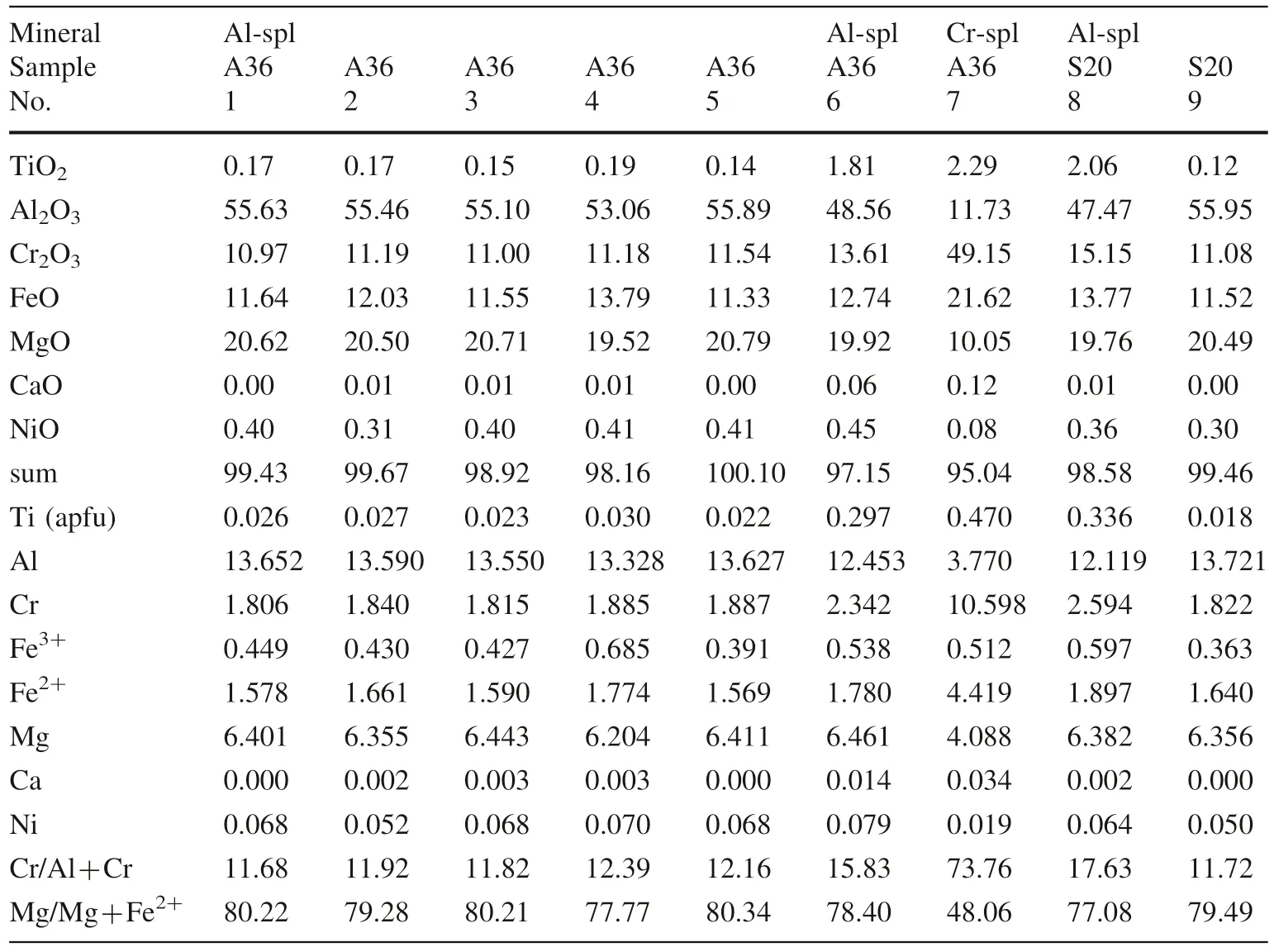
Table 7 Spinel compositions of Hosséré Sédé xenoliths and structural formulas on the basis of 32 oxygen anions
On Cr# vs Fo OSMA diagram (Fig.10,Arai 1994),studied xenoliths plot in mantle array,except one relative to the Cr-spinel.
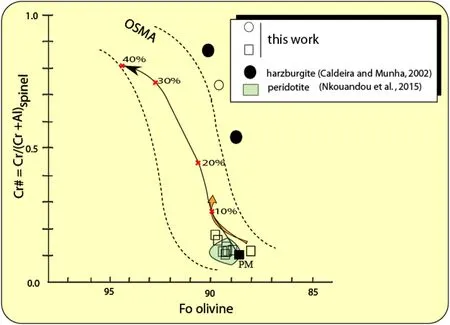
Fig.10 Cr#(=Cr/(Cr+Al))of spinel versus Fo of olivine crystals of Hosséré Sédé xenoliths plotted in the Olivine Spinel Mantle Array(OSMA)diagram of Arai(1994).Primitive Mantle(PM)composition of olivine and spinel according to McDonough and Sun (1995) and Johnson et al.(1990).Black arrow refers to the melting model of Arai(1994) and numbers (10% to 40%) correspond to melt extracted percentages
4.2.3 Thermobarometry
Graphical estimation with curves defined by Lindsley(1983)in En-Wo-Fs quadrilateral scheme of clinopyroxene(Fig.7) gives a wide range of temperatures,with a maximum value of about 1020°C,for a pressure of 5 kbars(0.5 GPa)but note that these thermometric curves are nearly the same between 1 atm and 10 kbar (1 GPa).
The results of the equilibrium temperature estimated for several pyroxene crystals of sample A36,through empirical thermometers,are listed in Table 8.O’Neill and Wall(1987) method gives a temperature range of 902–1045 °C,assuming a mantle pressure of 15 kbar(1.5 GPa)following these two authors.Temperature calculations after Mercier(1980)using Cr-Al solubility in clinopyroxene give similar equilibrium temperatures between 852 and 1028 °C with also three other higher values (1108–1204 °C).Wells(1977)formula based on clinopyroxene/orthopyroxene Caexchange yields a temperature range of 914–1105±50 °C.Putirka (2008) two pyroxenes geothermometer give both low values(936–1018°C)and higher values between 1086 and 1119 °C.Brey and Köhler (1990) two pyroxenes geothermometer give various values,high(1095–1164°C)or lower(866–1070°C).From these five geothermometers,the highest values (1085–1204 °C) seem to represent equilibria while lower ones (852–1070 °C) evidence late re-equilibration of the xenoliths (Nkouandou et al.2015).
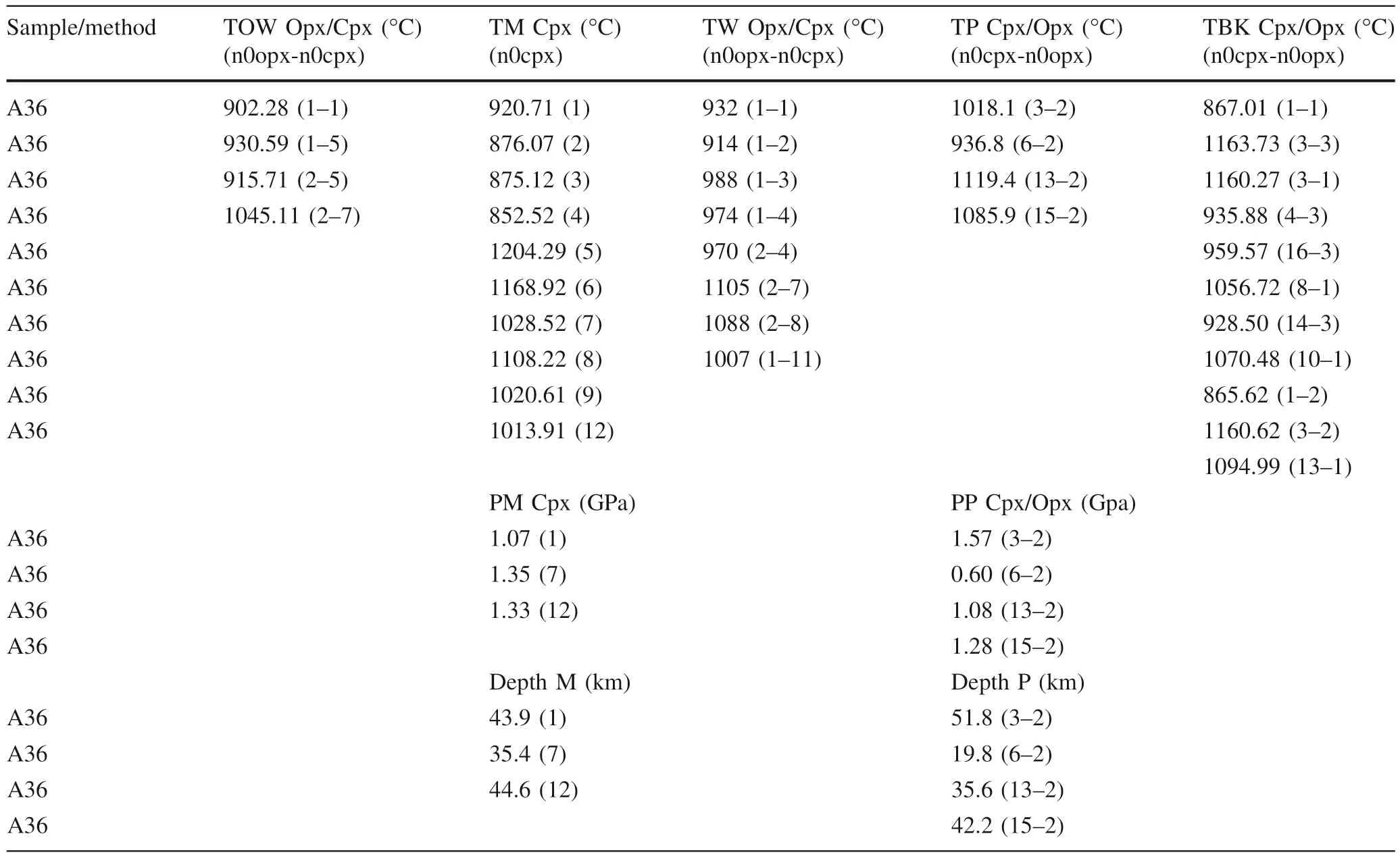
Table 8 Estimated temperatures,pressures and sampling depths of Hosséré Sédé xenoliths
Calculated pressures using Mercier (1980) formulas give equilibrium pressures of 1.07–1.35 GPa,while Putirka(2008)barometer gives 1.08–1.57 GPa,except one value at 0.60 GPa.The corresponding depths are bracketed between 35.6 and 51.8 km when using the conversion factor of 33 km×GPa-1,corresponding to the sampling depth(Fig.11).The pressures calculated for Hosséré Sédéxenoliths are in the 1.0 to 2.0 GPa range of those estimated by different authors (experimentations by O’Neill 1981;Gasparik 1987).

Fig.11 Pressure–temperature-depth diagram for Hosséré Sédéxenoliths (modified and adapted from Green and Falloon 1998)
5 Discussion
Various petrological studies on mantle peridotites sampled by basaltic lavas on their way to the surface (Nkouandou and Temdjim 2011;Nkouandou et al.2015;Njombie et al.2018) reveal the complexity of composition and structure of lithospheric mantle under Adamawa plateau,which may have evolved through the melting process.Moreover,metasomatism by a carbonatitic fluid phase could have occurred as witnessed by possible spongy rims on spinel(Fig.3C) (Carpenter et al.2002).
Hosséré Sédé lherzolite xenoliths display fertile mantle features: most olivine crystals are characterized by high Mg# ratios (88.05–90.03),high NiO (0.22–0.42 wt%) and low CaO(<0.1 wt%,see Simkin and Smith 1970)contents,except scarce crystals with fairly high CaO contents(0.13–0.27 wt%),suggesting the probable involvement of other processes experienced by Adamawa lithospheric mantle.Compositional variations are noticed on mineral analyses:high (up to 10.61 wt%) or low (0.64–0.89 wt%) Al2O3contents of clinopyroxene crystals,simultaneous occurrence of Al-and Cr-spinel crystals in the same sample,variations in TiO2contents (0.1–2.3 wt%) of spinels.
The most likely hypothesis which may explain these features is mantle upwelling under the studied area.The double distribution of clinopyroxene compositions (Mgrich and Al-poor vs.Mg-poor and Al-rich,Fig.12)as well as the double distribution of spinel (Cr# 65–90 vs.Cr# of 10–60),suggest different degrees of extracted melt (from 5%–10% until 20%–25%,Fig.12) in the spinel stability field rather than two mantle stages with garnet peridotite and later spinel peridotite(see discussions in Rudnick et al.1993;Melchiorre et al.2020;Rizzo et al.2021;Casetta et al.2022).OSMA diagram (Fig.10) argues for similar values of 5%–10% of extracted melt (for Al-spinel) until 25% for Cr-spinel.
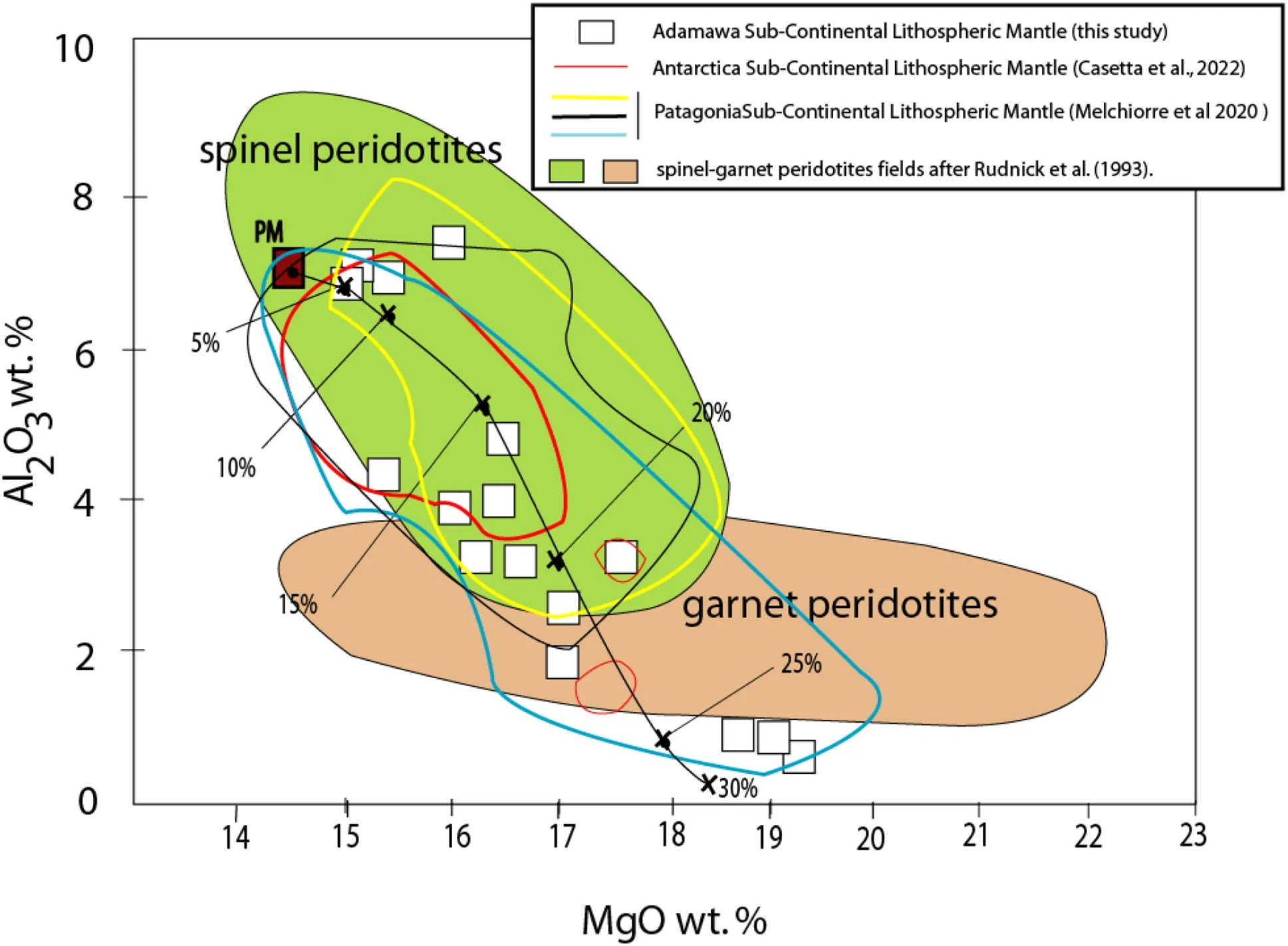
Fig.12 Al2O3 versus MgO of clinopyroxene of Hosséré Sédéxenoliths.Note that the analysis with Al2O3=10.61 wt% and MgO=12.11 wt% plots outside of this diagram.Fields of the spinel peridotites and garnet peridotites after Rudnick et al.(1993).Fields of clinopyroxenes from Patagonia (Melchiorre et al.2020) and from Antarctica (Casetta et al.2022) added for comparison.Black curve indicates the melt extracted percentage,according to the melting model of Bonadiman and Coltorti (2011) and Upton et al.(2011),from a starting Primitive Mantle (PM) composition of Sun and McDonough (1989) and McDonough and Sun (1995)
In that way,previous geophysical data have emphasized a migration of lithosphere—asthenosphere boundary from 120 to 80 km under the whole Adamawa plateau (Browne and Fairhead 1983;Poudjom Djomani et al.1992,1997;Nnange et al.2000) and abnormal hot mantle materials located at depths between 70 and 90 km (Dorbath et al.1986) coupled to adiabatic decompression.
Silica-undersaturated characteristics of Adamawa volcanism (Nkouandou et al.2008,2010,2015) argue for mantle decompression related to crustal extension,indicating eroded sub-lithospheric mantle after upwelling(Hidas et al.2019).The Hosséré Sédé mantle xenoliths may thus originate from evolution of spinel-bearing subcontinental lithospheric mantle controlled by mantle upwelling.Metasomatism process through melt infiltration could be also associated to this evolution so as tectonic work or re-work of Pan African strike slip faults delimiting the northern Adamawa plateau.Anyway,ongoing major and trace elements geochemical and Sr–Nd isotopic analyses on Hosséré Sédé lherzolites are mandatory to decipher the complex evolution underwent by the lithospheric mantle under the volcano.
6 Conclusion
Petrographical and detailed mineralogical studies carry out on Hosséré Sédé lherzolites in northern Ngaoundéré area evidence the complex history undergone by sub-lithospheric mantle under the Adamawa plateau.
Mineral phases in Hosséré Sédé lherzolites present larger ranges of chemical composition in comparison with some other lherzolites described in the Adamawa plateau(Nkouandou and Temdjim 2011;Nkouandou et al.2015;Njombie et al.2018).In that way,in Hosséré Sédé we note more various CaO contents in olivine,the occurrence of two groups of clinopyroxene,and the coexistence of two types of spinel.
The subcontinental mantle under the Adamawa plateau suffered partial melting extraction after decompression due to the migration of lithosphere-asthenosphere boundary.In addition,this mantle could have experienced metasomatism processes.
AcknowledgementsAuthors greatly thank the“Agence Universitaire de la Francophonie (AUF)” for financial support for microprobe analyses.We are grateful to the University of Paris-Saclay,France,for thin sections.Fruitful remarks by B.Bonin and A.Pouclet have greatly help to improve the manuscript.F.Casetta and an anonymous reviewer are thanked for careful reviews.
Authors’contributionOFN,AFM,ZNNN,AAS and HA made field studies,JMB made electron microprobe analyses,OFN and JMB prepared the manuscript.
Funding“Agence Universitaire de la Francophonie (AUF)”.
Data availabilityNo.
DeclarationsConflict of interest On behalf of all authors,the corresponding author states that there is no conflict of interest.
- Acta Geochimica的其它文章
- The cooling models of Earth’s early mantle
- Distribution,risk evaluation,and source analysis of the heavy metals in the sediment deposition of the lower Shichuanhe River,Shaanxi,China
- Decoding the nature of interaction between felsic clasts and mafic magma in a subvolcanic magma chamber from amphibole–titanite transformation and chemistry
- Isotopic analysis based on terahertz spectrum
- In situ infiltration-precipitation processes in some rock systems
- Magma source and tectonic setting of the Dunde granite in the Western Tianshan: constraints from geochronology,geochemistry,and Sr–Nd–Hf isotopes

